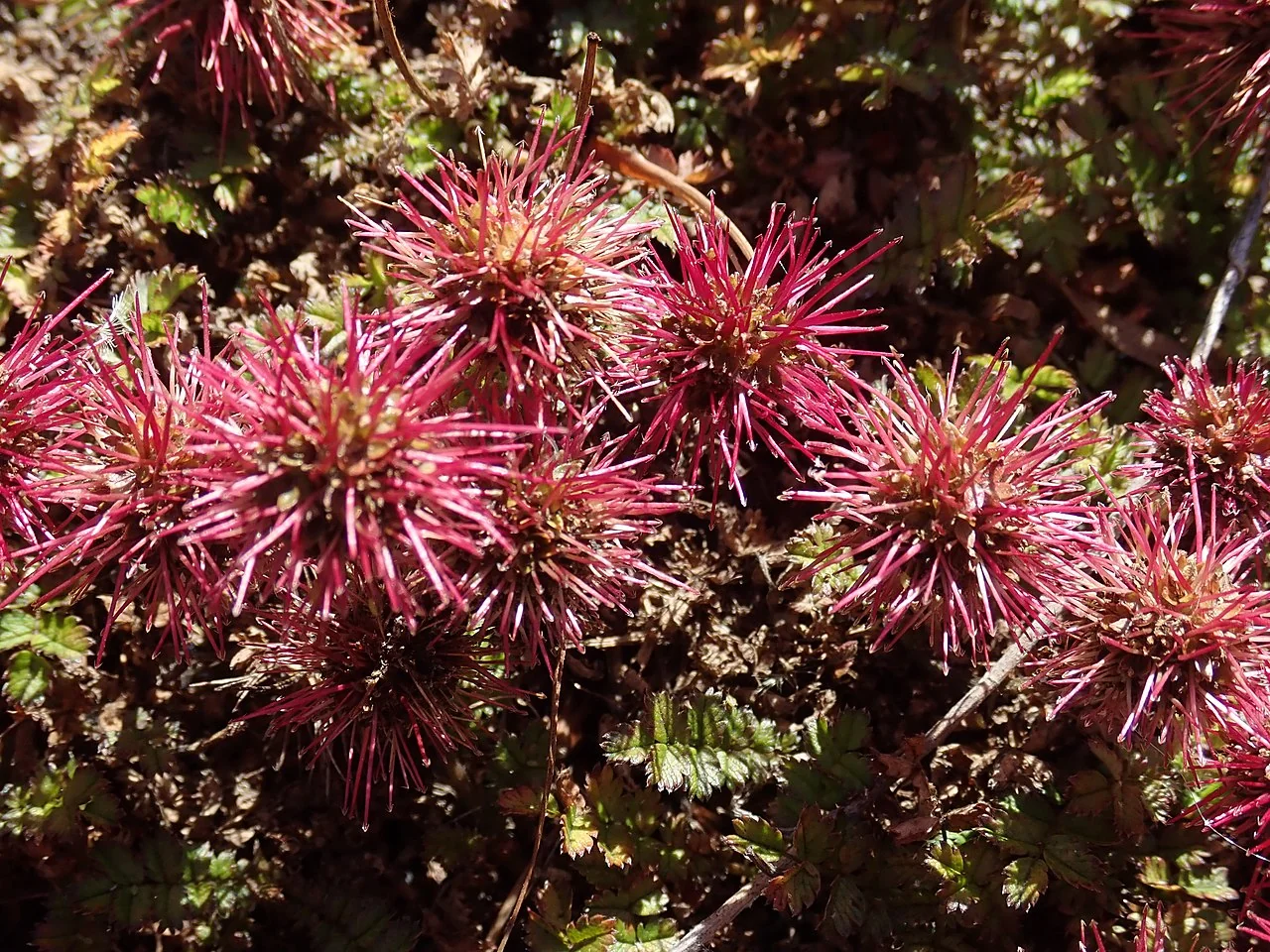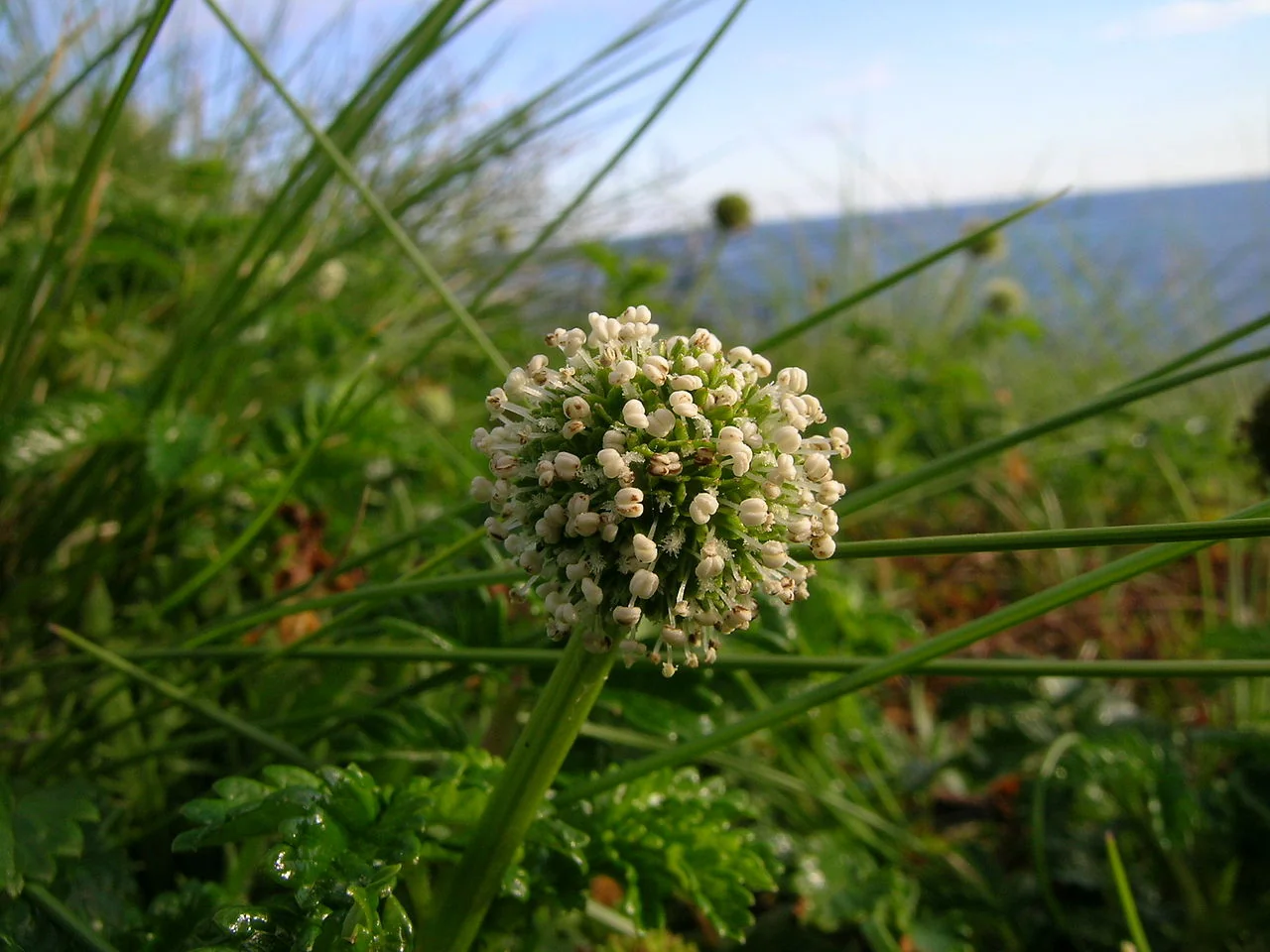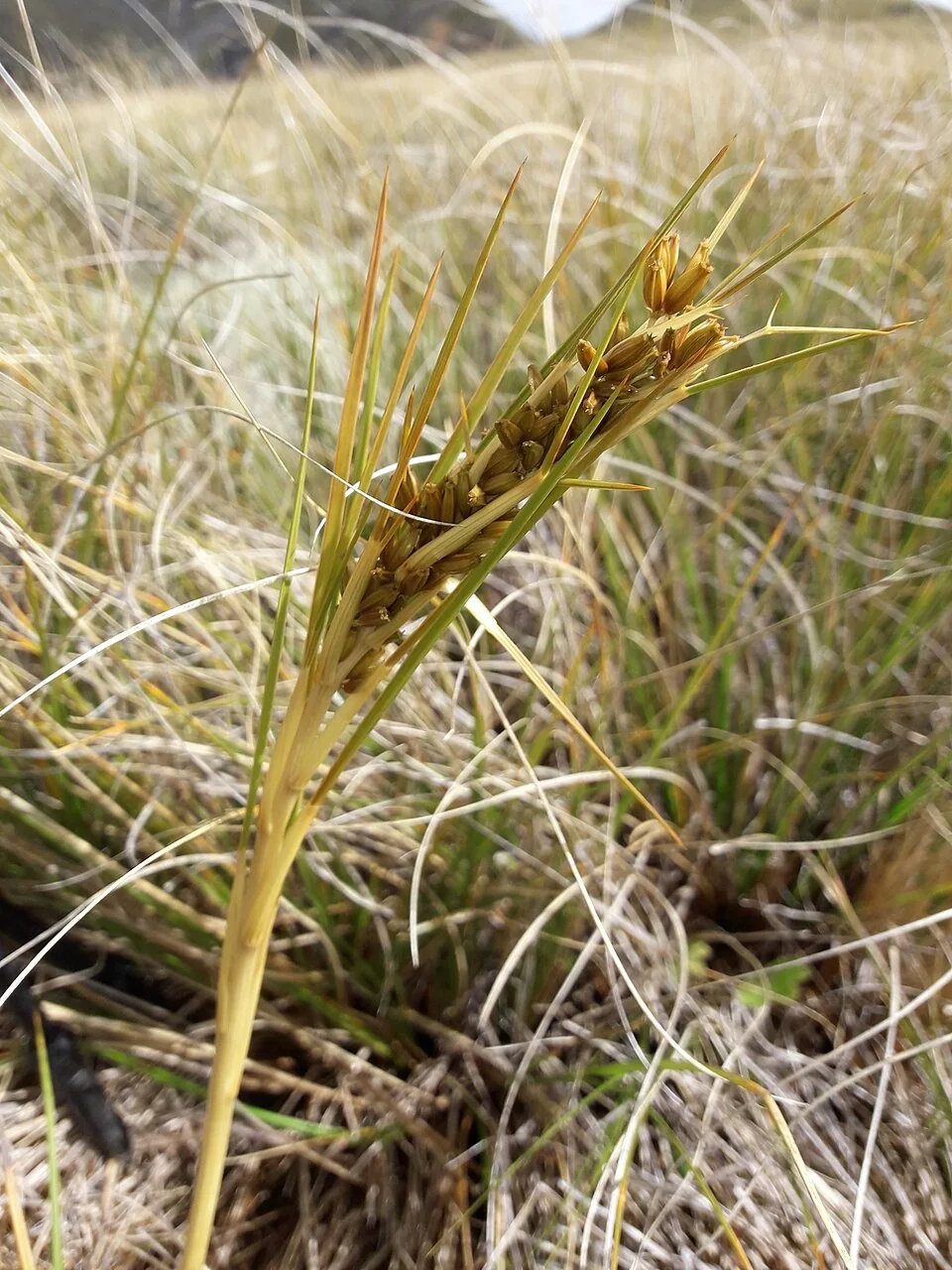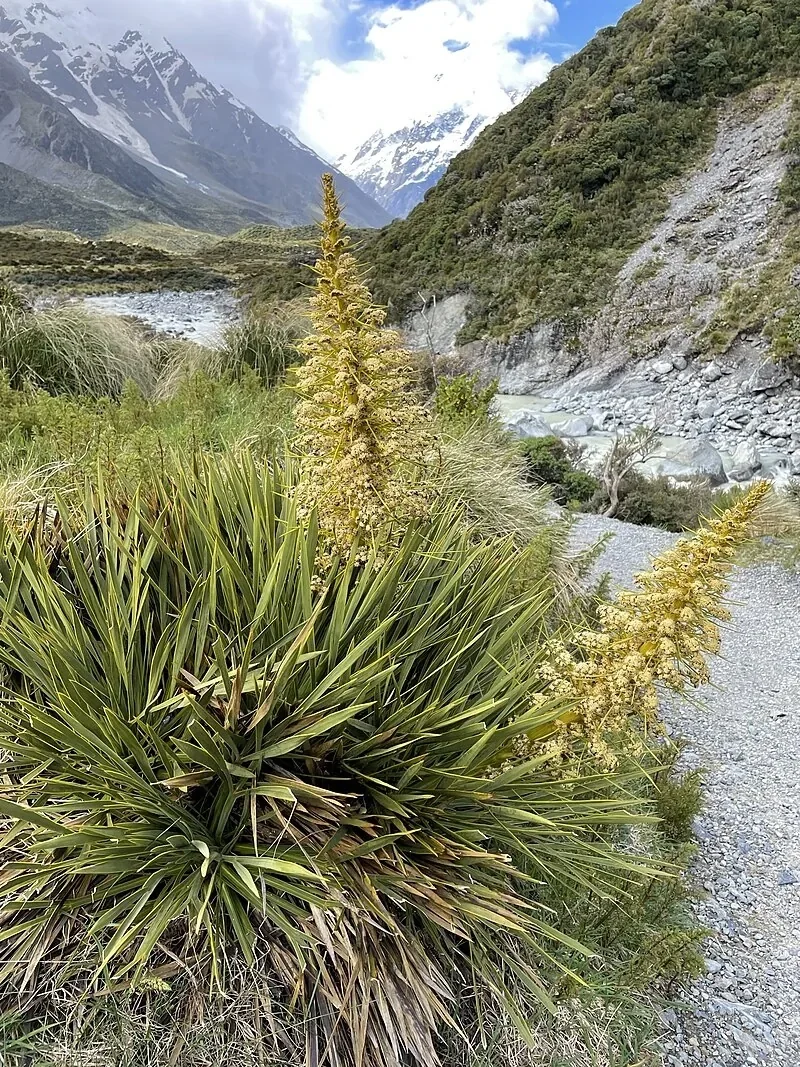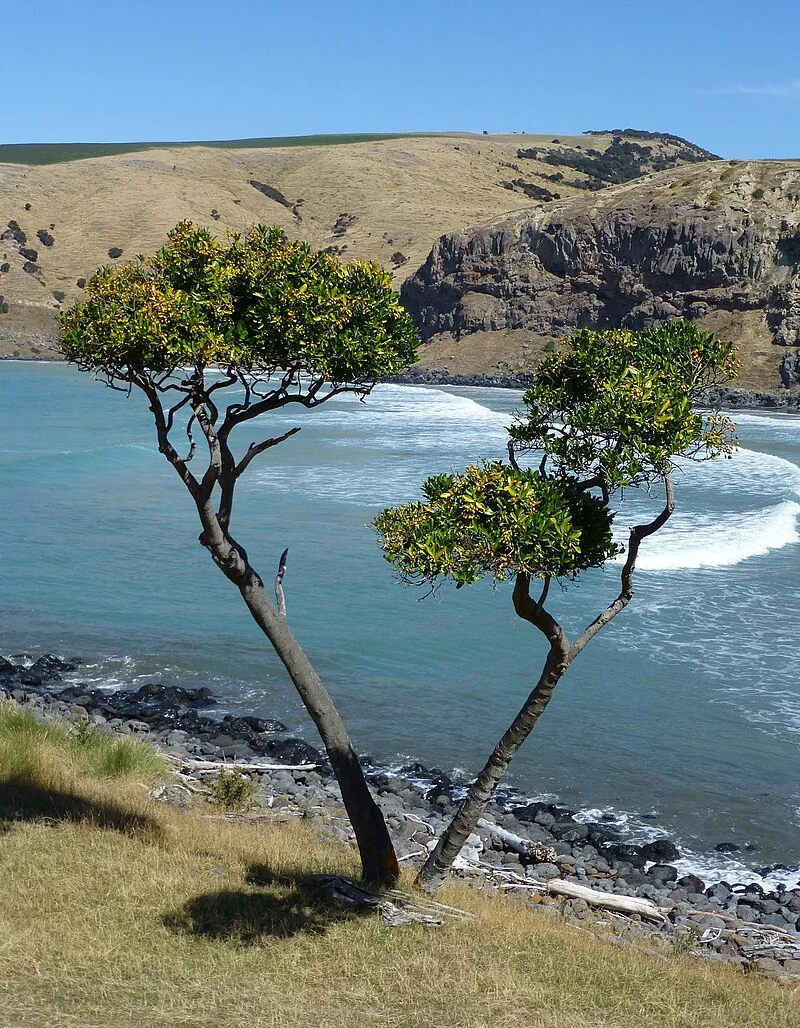
Karaka
Corynocarpus laevigatus
Karaka ( Corynocarpus laevigatus ) represents one of New Zealand's most culturally and ecologically significant native trees , standing as a magnificent evergreen that has shaped both Māori civilization and the country's coastal forest ecosystems for centuries. This impressive tree, reaching heights of 15-20 meters with massive trunks up to 60cm in diameter, creates distinctive forest groves with its broad, dark green canopy and characteristically large, leathery leaves that can measure up to 25cm in length, providing year-round shade and shelter. The tree's most remarkable feature lies in its bright orange-yellow berries, each containing a single large kernel that, after complex traditional processing to remove toxins, provided a crucial carbohydrate source for Māori communities - so important that entire settlements were established near karaka groves, and the trees were carefully cultivated and protected across generations. The striking contrast between the glossy, dark foliage and vibrant orange fruit creates spectacular visual displays in autumn and winter, while the tree's robust form and salt tolerance make it ideally suited to coastal environments throughout the North Island and northern South Island. Beyond its cultural importance, Karaka plays a crucial ecological role as a keystone species, with its large berries providing essential food for native birds, particularly the kererū ōī (New Zealand pigeon), which serves as the primary seed disperser and helps maintain forest connectivity. The tree's dense growth habit creates important habitat for numerous native species, while its ability to form extensive groves helps stabilize coastal soils and provide windbreak protection. However, the powerful toxins in the raw kernels - compounds that proved deadly to European settlers unfamiliar with proper preparation methods - serve as a reminder of the deep traditional knowledge required to safely utilize this remarkable plant, highlighting the sophisticated understanding that Māori developed over generations of sustainable interaction with New Zealand's unique flora.

Plant Description
Botanical Features
Corynocarpus laevigatus , commonly known as Karaka or New Zealand laurel, is a medium-sized evergreen tree endemic to New Zealand. It typically grows to heights of 15-20 meters, with a stout trunk that can reach up to 60 centimeters in diameter. The bark is generally grey. Its leaves are distinctive: leathery, dark to bright green, glossy, and typically 15-30 cm long, with an elliptic to obovate-oblong shape. From August to November, the tree produces small, greenish-yellow flowers in erect panicles. These are followed by large, oval-shaped, orange fruits, about 30-40 mm in length, which ripen from December to February. Each fruit contains a single, poisonous seed. The tree is mostly found in coastal areas, though it can also grow inland in the North Island of New Zealand, and on the Chatham Islands, Kermadec Islands, and Three Kings Islands.
Quick Facts
| Scientific Name | Corynocarpus Laevigatus |
|---|---|
| Height | 10-15 m |
| Spread | 8-12 m |
| Water Needs | Moderate |
| Light | Full sun to part shade |
| Frost Tolerance | Poor to moderate |
| Salt Tolerance | Good |
| Growth Rate | Moderate |
| Lifespan | Very long |
Climate Best Suited to
Karaka ( Corynocarpus laevigatus ) thrives in warm, coastal and lowland areas with protection from frost and good drainage. It adapts well to typical New Zealand growing conditions with appropriate care and positioning.
Regional Suitability
| Whangārei | Ideal |
| Auckland | Ideal |
| Hamilton | Suitable |
| Rotorua | Suitable |
| Tauranga | Ideal |
| Gisborne | Ideal |
| New Plymouth | Ideal |
| Whanganui | Ideal |
| Palmerston North | Suitable |
| Napier | Ideal |
| Wellington | Ideal |
| Nelson | Ideal |
| Christchurch | Suitable |
| Dunedin | Suitable |
| Invercargill | Suitable |
| City | Climate Suitability |
|---|
Natural Habitat
Karaka ( Corynocarpus laevigatus ) is a prominent medium-sized evergreen tree endemic to New Zealand, primarily inhabiting coastal and lowland forests. Its natural distribution is concentrated in the northern half of the North Island, extending southwards to coastal areas of the lower North Island and specific locations in the South Island, such as Banks Peninsula and Okarito. It is also a significant component of the flora on the Chatham Islands, Kermadec Islands, and Three Kings Islands. Karaka thrives in temperate conditions, preferring full sun and moist, well-drained, fertile soils. While highly tolerant of coastal conditions and salt spray, its relative intolerance to frost, especially when young, limits its inland presence in colder regions. Historically, its distribution has been influenced by Māori plantings, making its exact indigenous range somewhat uncertain, but its adaptability has led to its naturalization in lowland forests beyond its original boundaries.
Plant Conservation
Corynocarpus laevigatus , commonly known as karaka or New Zealand laurel, is classified as "Not Threatened" under the New Zealand Threat Classification System (NZTCS). The IUCN Red List of Threatened Plants Status indicates that this taxon has not yet been assessed. It is considered abundant in its native range.
However, it is naturalized and considered an invasive species in Hawaii.
Growing Requirements
Soil Requirements
Karaka ( Corynocarpus laevigatus ) performs best in well-draining soil that retains adequate moisture. Like most New Zealand natives, it prefers soils that don't become waterlogged but maintain consistent moisture levels. Good drainage is essential for healthy root development.
- Well-draining soil essential for healthy growth
- Prefers consistent moisture without waterlogging
- Adapts to various soil types with good drainage
- Benefits from organic matter incorporation
- Mulching helps retain moisture and suppress weeds
Light Requirements
Karaka ( Corynocarpus laevigatus ) performs well in full sun to partial shade conditions. Like many New Zealand natives, it adapts to various light conditions but typically shows best growth and form in positions that receive adequate sunlight throughout the day.
- Full sun to partial shade positions
- At least 4-6 hours of direct sunlight daily
- Tolerates light shade in warmer climates
- Morning sun particularly beneficial
Water Requirements
Karaka ( Corynocarpus laevigatus ) requires regular watering during establishment, typically for the first 1-2 years. Once established, it becomes more drought-tolerant but benefits from consistent moisture during dry periods. Avoid overwatering which can lead to root problems.
- Regular watering during establishment phase
- Moderate drought tolerance once established
- Consistent moisture during dry periods beneficial
- Avoid waterlogged conditions
- Mulching helps conserve soil moisture
Planting Guide
Planting Karaka ( Corynocarpus laevigatus ) is a rewarding experience, as this resilient native tree establishes well in a range of conditions, particularly in coastal and lowland areas. Following a few key steps will ensure your Karaka thrives, growing into a magnificent specimen that will support local wildlife and add a touch of classic New Zealand character to your landscape.
Site Selection
- Light: Choose a location that receives full sun to partial shade. While Karaka can tolerate some shade, it will produce the most abundant fruit in a sunny spot.
- Soil: The soil should be fertile and well-draining. Karaka is adaptable to different soil types, including sandy and clay loams, but will not tolerate waterlogged conditions.
- Space: Allow ample space for the tree to reach its mature size of up to 15 meters in height and 10 meters in spread.
- Protection: Young trees are sensitive to frost, so choose a site that offers some protection from cold drafts, especially in cooler climates.
Planting Instructions
- Timing: The best time to plant Karaka is in spring or early summer, when the soil is warm and the tree can establish its root system before winter.
- Planting: Dig a hole that is twice the width and the same depth as the root ball. Gently remove the plant from its container and place it in the hole. Backfill with soil, ensuring the tree is planted at the same depth as it was in the container.
- Watering: Water the tree thoroughly after planting to settle the soil and eliminate any air pockets.
Ongoing Care
- Watering: Keep the soil consistently moist, especially during the first few years of growth. Once established, Karaka is moderately drought-tolerant but will benefit from occasional deep watering during dry spells.
- Mulching: Apply a layer of organic mulch around the base of the tree to help retain soil moisture, suppress weeds, and provide nutrients as it breaks down.
- Pruning: Karaka naturally forms a well-shaped tree and requires minimal pruning. Remove any dead, damaged, or crossing branches as needed.
Toxicity Warning
It is crucial to remember that the raw kernels of Karaka berries are highly poisonous and should never be eaten. The toxins can cause severe illness and even death. While Māori had traditional methods of preparing the kernels to make them safe for consumption, this requires extensive knowledge and is not recommended. Keep children and pets away from the fruit.
Ecological Role
Environmental Benefits
Karaka plays a multifaceted ecological role, primarily within its native New Zealand ecosystems. In its natural habitat, which includes coastal cliffs, dunes, and lowland forests, karaka functions as a durable coastal canopy and edge tree. It provides shade and wind buffering, and its dense canopy creates cool, sheltered understorey microclimates. The tree's flowers offer nectar, and its seasonal orange fruits are a valuable food source for native New Zealand birds, particularly the kererū ōī (New Zealand pigeon) and the Chatham Islands pigeon, which are crucial for dispersing its large seeds. Additionally, Karaka serves as a host species for the endemic New Zealand beetle Oemona hirta .
However, outside its natural range or when its populations become overly dense, karaka can be considered an environmental weed. Its "aggressive regeneration" and prolific seeding can lead to it outcompeting and excluding other native plant species, thereby altering the composition and ecological processes of local plant communities.
Uses and Significance
Garden Uses
- Excellent for native plant gardens and restoration
- Suitable for naturalistic landscape designs
- Low maintenance once established
- Contributes to local biodiversity
- Attractive to beneficial native wildlife
Cultural Significance
Corynocarpus laevigatus , known as karaka by Māori and k pi by Moriori, holds significant cultural and historical importance for both indigenous peoples of New Zealand. It is considered a taonga (cultural treasure).
Key Aspects of Cultural Significance Include:
- Food Source: Primarily, karaka was a vital food source. The flesh of the fruit was consumed, and the kernels, though containing a lethal neurotoxin called karakin, were highly prized after careful preparation to remove the toxin. This preparation was an important cultural practice, and the prepared kernels could be eaten fresh, stored, or ground into flour.
- Māori Mythology: In Māori mythology, C. laevigatus is believed to have originated from Hawaiki, the ancestral homeland of the Māori people.
- Traditional Medicine (Rongoā Māori): Māori used the leaves of the karaka tree for medicinal purposes. The undersides of the leaves were used to draw out infections, while the fresh upper surfaces were applied to heal injured skin.
- Moriori Dendroglyphs (Rākau Momori): On the Chatham Islands, Moriori people carved depictions of their ancestors onto karaka trees, known as rākau momori. These carvings are considered internationally significant and unique to Moriori culture.
- Spiritual Significance: The tree also held powerful spiritual significance, with stories arising about its journey from Hawaiki.
- Widespread Planting: The exact indigenous distribution of karaka is uncertain due to its widespread historic planting by Māori, who cultivated it across the country for its food value. It is often found in association with Māori cultural deposits and can be seen planted in straight lines, circles, or groves in areas of former Māori occupation.
Despite its cultural value, karaka is also viewed as an environmental weed outside its natural range, as it can outcompete native vegetation and disrupt local ecosystems. The management of karaka presents a challenge in balancing its cultural significance with ecological integrity.
Landscaping Uses
Karaka ( Corynocarpus laevigatus ) is a highly versatile and attractive native tree that offers numerous landscaping possibilities, particularly in coastal and warmer, sheltered environments. Its dense, evergreen foliage, robust growth habit, and vibrant orange berries make it a striking addition to various garden designs.
Key Landscaping Applications:
- Coastal and Shelter Tree: Due to its exceptional tolerance to wind and salt spray, Karaka is an ideal choice for coastal gardens. It provides excellent shade and acts as a natural windbreak, protecting more delicate plants.
- Feature or Specimen Tree: With its glossy, dark green leaves and eye-catching clusters of orange fruits, Karaka makes a magnificent specimen tree in larger gardens, parks, and open spaces. Its distinctive form adds architectural interest to the landscape.
- Screens and Hedges: When planted in rows, Karaka forms effective screens or informal hedges, offering privacy and reducing noise. It can also be used as a substantial background hedge in larger properties.
- Native Garden and Restoration Projects: Karaka is an invaluable component of native plant gardens and ecological restoration efforts. It contributes significantly to local biodiversity by providing food and habitat for native birds and insects.
- Container Planting: Younger Karaka plants can be successfully grown in large containers, making them suitable for patios, courtyards, or smaller urban gardens where space is limited.
When incorporating Karaka into your landscape, consider its mature size to ensure it has ample space to thrive. Its dense canopy provides year-round greenery and a lush backdrop for other plantings. Remember to site it appropriately, especially in areas prone to frost, as young plants can be sensitive to cold.
Seasonal Care Calendar
Spring
Spring is an active growth period for Karaka ( Corynocarpus laevigatus ). New growth emerges and this is an ideal time for planting new specimens. Monitor soil moisture as temperatures warm and growth accelerates.
- Active growth period with new foliage development
- Ideal time for planting new specimens
- Monitor soil moisture as temperatures rise
- Apply organic mulch if needed
Summer
Summer is typically the main growing season for Karaka ( Corynocarpus laevigatus ). Ensure adequate watering during hot, dry periods, especially for young plants. Established plants show good heat tolerance with appropriate care.
- Peak growing season with active development
- Monitor watering needs during hot weather
- Young plants need consistent moisture
- Established plants show good heat tolerance
Autumn
During autumn, Karaka ( Corynocarpus laevigatus ) begins to slow its growth as temperatures cool. This is another good time for planting as conditions become more favorable. Reduce watering frequency but maintain soil moisture.
- Growth slows as temperatures moderate
- Good time for planting new specimens
- Reduce watering frequency gradually
- Maintain soil moisture without overwatering
Winter
Winter is typically a dormant period for Karaka ( Corynocarpus laevigatus ), with minimal growth activity. Reduce watering but ensure plants don't completely dry out. Most New Zealand natives are cold-hardy and require minimal winter protection.
- Dormant period with minimal growth activity
- Reduce watering but avoid complete drying
- Generally cold-hardy in most New Zealand climates
- Minimal winter protection required
When to Prune and How Much
Karaka ( Corynocarpus laevigatus ) generally requires minimal pruning to maintain its natural form and health. Most maintenance involves removing dead or damaged growth and light shaping if needed.
- Remove dead, damaged, or diseased growth as needed
- Light pruning to maintain shape if desired
- Prune after flowering if applicable
- Avoid heavy pruning which can stress the plant
- Use clean, sharp tools to prevent disease
- Most natives maintain good form without regular pruning
Always use clean, sharp tools when pruning to minimize disease risk. Native plants typically maintain their natural form well and often require less intervention than exotic species.
How to Grow Karaka
Karaka is a handsome and robust native tree, highly valued for its glossy foliage, attractive orange fruits, and its ability to thrive in coastal conditions. It is a relatively easy tree to grow, especially in warmer, frost-free environments. While it can tolerate a range of soil types, good drainage and consistent moisture are key to its success. Understanding its propagation methods is essential for those looking to cultivate this significant New Zealand species, but it is crucial to remember the toxicity of its seeds.
From Seed
Propagating Karaka from seed is the most common and generally reliable method. Collect fresh, ripe orange fruits from the tree. It is crucial to remove the fleshy pulp entirely, as it contains toxins and can inhibit germination. Clean the seeds thoroughly. To hasten germination, scarify the hard seed coat by lightly sanding or nicking it, then soak the seeds in cold water for 48 hours, changing the water daily. Plant the treated seeds about 10-20mm deep in a well-draining seed-raising mix. Maintain consistent moisture and warm conditions (20-25°C). Germination can be variable, ranging from a few weeks to several months. Once seedlings have developed a few true leaves, they can be potted into individual containers and grown in a sheltered, frost-free location.
From Cuttings
Propagation of Karaka from cuttings can be challenging but is possible with careful attention to detail. Take semi-hardwood cuttings from healthy, current season's growth in spring or early summer. Cuttings should be about 4-6 inches long. Remove the lower leaves and dip the cut end in a rooting hormone. Plant the cuttings into a well-draining, sterile cutting mix, such as a blend of perlite and peat. Maintain high humidity around the cuttings, perhaps by placing them under a plastic dome or in a propagator, and provide bottom heat to encourage root development. Keep the medium consistently moist but not waterlogged. Rooting can take several months, and success rates can vary. Once rooted, the new plants can be potted on and grown in a sheltered environment until they are ready for planting.
Pests and Diseases
Karaka is generally a robust and healthy tree, resistant to most common pests and diseases. However, like all plants, it can be susceptible to certain issues, particularly when stressed or grown in suboptimal conditions.
Pests
While Karaka is not a primary target for most herbivorous insects, it can occasionally be affected by common garden pests such as aphids, scale insects, and mealybugs, especially on new growth. In its natural environment, it serves as a host for the endemic New Zealand beetle Oemona hirta . The karaka gall mite ( Aculus corynocarpi ) can cause galls to form on the leaves, and while this is often a cosmetic issue, the mite is also a known vector for emaraviruses.
Diseases
Karaka is susceptible to the Karaka kahu purepure virus (KOPV), a novel emaravirus that is likely transmitted by the karaka gall mite. This virus can cause chlorotic leaf spots and other foliar symptoms. Cucumber mosaic virus (CMV), transmitted by aphids, has also been found in Karaka trees, leading to leaf mottling and line patterns. Good air circulation and healthy growing conditions can help to minimize the risk of fungal diseases, although these are not commonly reported as significant issues for Karaka.
Bonus Tip
Expert Growing Advice
Karaka ( Corynocarpus laevigatus ) produces large orange drupes containing karakin, a potent toxin to people, dogs and livestock. In home gardens, rake up fallen fruit promptly and avoid planting directly over paths or play areas. If you want heavy fruiting for wildlife, site trees in a warm, sheltered spot - but be prepared to net or mulch beneath the canopy during drop to keep pets safe.




